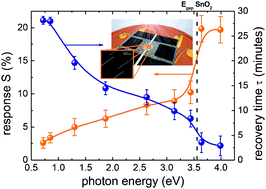A model for the response towards oxidizing gases of photoactivated sensors based on individual SnO2nanowires
Abstract
The paper presents a quantitative model to elucidate the role of impinging

* Corresponding authors
a
EME/XaRMAE/IN2UB, Departament d’Electrònica, Universitat de Barcelona, C/ Martí i Franquès 1, Planta 2, E-08028 Barcelona, Spain
E-mail:
dprades@el.ub.es
b
Electronic Nanosystems S. L., Barcelona, Spain
E-mail:
fhernandezra@e-nanos.com
c Department of Inorganic Chemistry, University of Cologne, D-50939 Cologne, Germany
d Nanocrystalline Materials and Thin Film Systems, Leibniz-Institute of New Materials, D-66123 Saarbruecken, Germany
e
Institut de Recerca en Energia de Catalunya (IREC), C/ Josep Pla 2, B2, Ground Floor, E-08019 Barcelona, Spain
E-mail:
jrmorante@irec.cat
The paper presents a quantitative model to elucidate the role of impinging

 Please wait while we load your content...
Something went wrong. Try again?
Please wait while we load your content...
Something went wrong. Try again?
J. D. Prades, R. Jimenez-Diaz, M. Manzanares, F. Hernandez-Ramirez, A. Cirera, A. Romano-Rodriguez, S. Mathur and J. R. Morante, Phys. Chem. Chem. Phys., 2009, 11, 10881 DOI: 10.1039/B915646A
To request permission to reproduce material from this article, please go to the Copyright Clearance Center request page.
If you are an author contributing to an RSC publication, you do not need to request permission provided correct acknowledgement is given.
If you are the author of this article, you do not need to request permission to reproduce figures and diagrams provided correct acknowledgement is given. If you want to reproduce the whole article in a third-party publication (excluding your thesis/dissertation for which permission is not required) please go to the Copyright Clearance Center request page.
Read more about how to correctly acknowledge RSC content.
 Fetching data from CrossRef.
Fetching data from CrossRef.
This may take some time to load.
Loading related content
